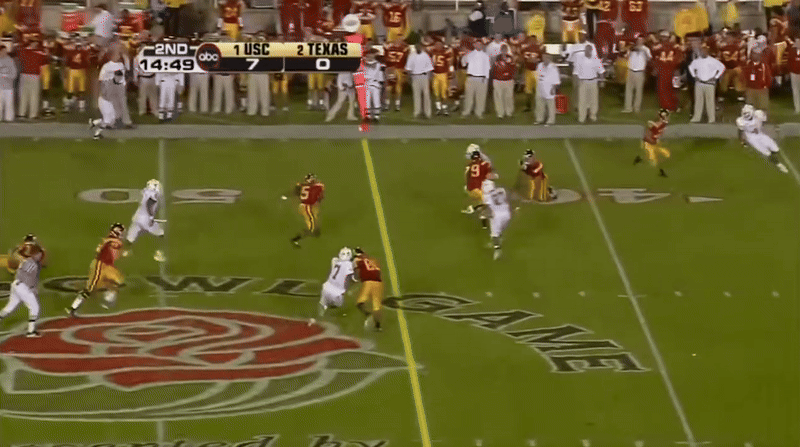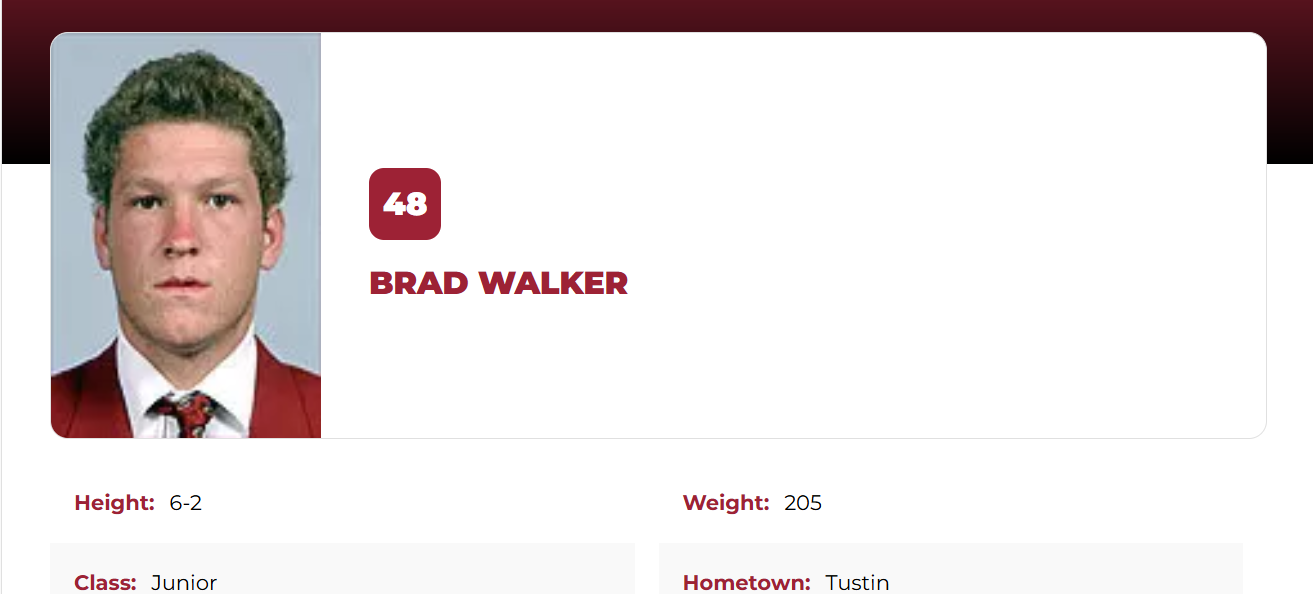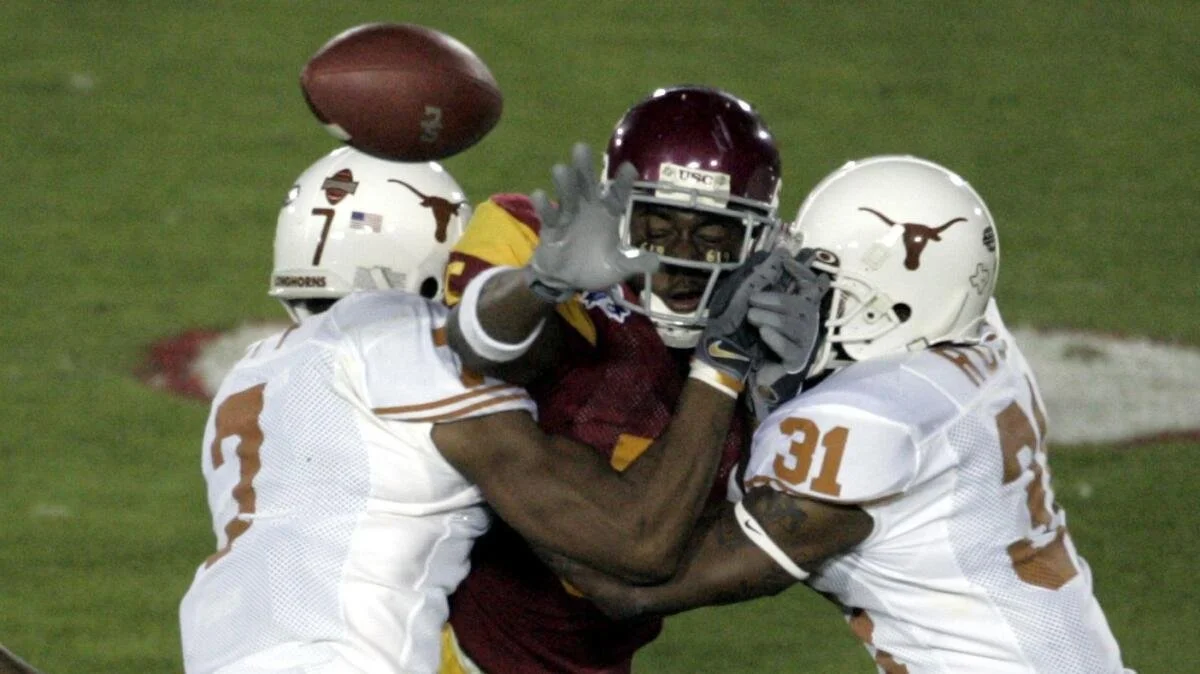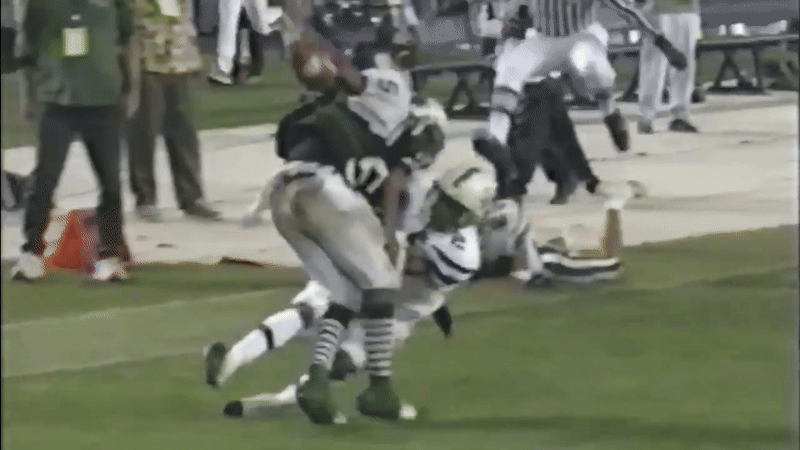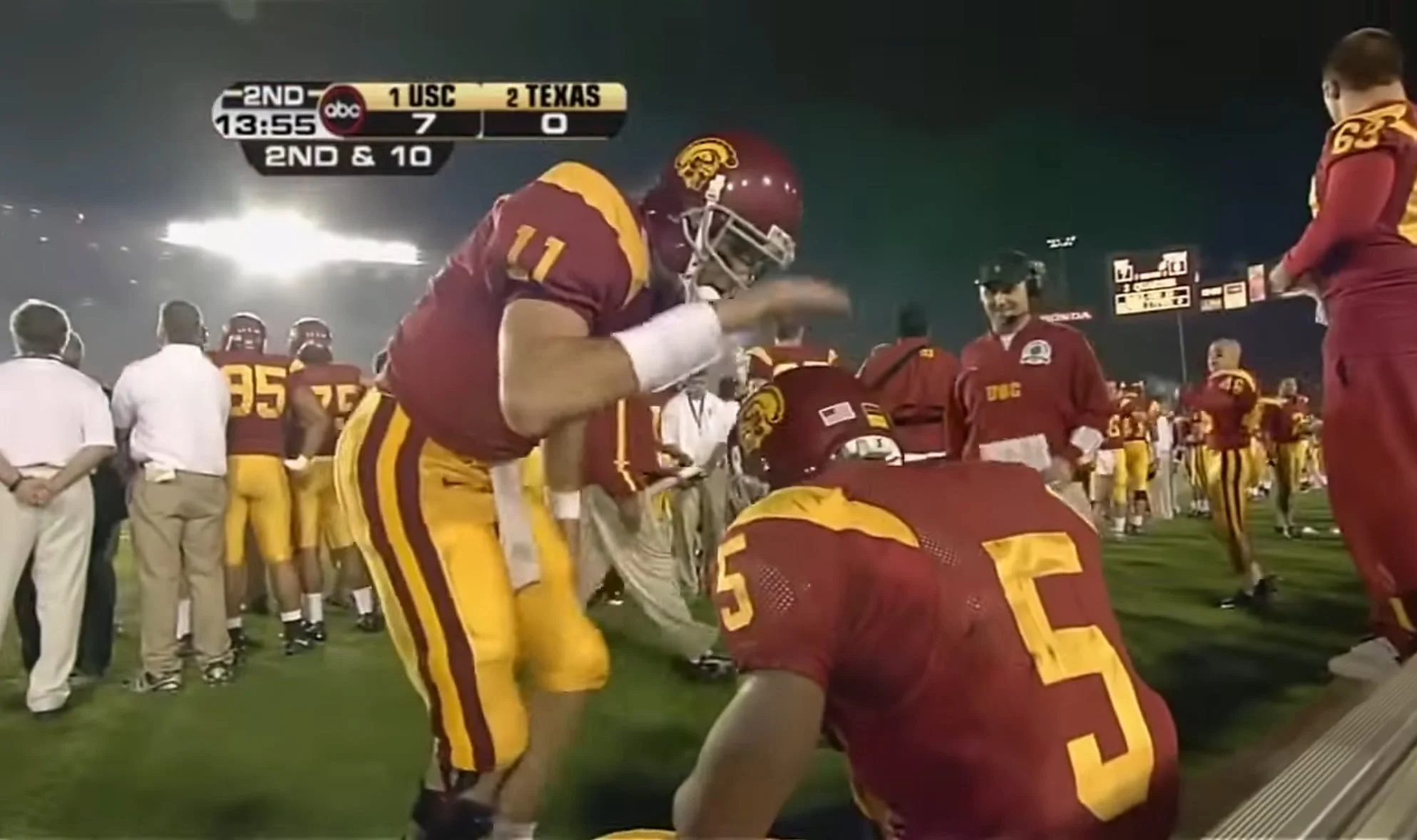Chapter one
The Decision Everyone Misunderstood
Rose Bowl, January 4, 2006. Second Quarter.
The scoreboard read USC 7, Texas 0. Not exactly desperation time.
Ninety-three thousand fans packed the Rose Bowl, creating a wall of sound that made the stadium feel like it was breathing. Keith Jackson, the voice of college football, was on his last call ever. The sun was setting over the San Gabriel Mountains, painting the field in that perfect California golden hour light that makes every play look like it belongs in a highlight reel.
And then it happened.
Reggie Bush—number 5, the most electric player in college football, the Heisman Trophy winner who made defenders look like they were moving through molasses—caught a screen pass from Matt Leinart at the fifty-yard line. Bush was already at the second level before the Texas pursuit could converge, his vision reading the alley like a seasoned back scanning for daylight. The kid from San Diego had that rare gear—the kind where defenders think they have the angle until he's already three yards past their outstretched arms.
But Texas wasn't the number two team in the country by accident. Three white jerseys meet around Bush from different angles—a geometric equation of pursuit that would trap even the fastest man on the field. The Longhorns had him dead to rights.
And that's when Reggie Bush made the decision that would echo through football history.
He pitched the ball.
"Oh, look out! Fumble!" Keith Jackson's voice cracked through millions of television speakers.
The lateral hit the turf. Texas strong safety Michael Huff pounced on it.
"Texas has got it!" Jackson confirmed what everyone could see but nobody could believe. "He was trying to lateral to a trailing teammate. That was a bonehead play."
The announcers piled on. Dan Fouts called it "trying to do too much." "selfish football." The narrative was instant and unanimous: Reggie Bush had committed one of the great sins of football. He'd gotten greedy. He'd tried to be a hero.
But here's what nobody talked about in that moment—and what nobody talks about even now, almost two decades later.
The play was almost geometrically perfect.
The Ghost in the Machine
To understand why Bush's decision was brilliant rather than boneheaded, you need to understand who was trailing him and why. That ghost in USC cardinal and gold, desperately trying to catch up to the play, was Brad Walker—a 6-foot-2,, 205-pound wide receiver wearing number 48.
Walker wasn't some random player who happened to be on the field. He was there by design, fulfilling a very specific role in USC's offensive architecture. On this particular play—a screen pass to Bush off play-action—Walker's job was devastatingly simple: get downfield and block.
Think about it from Walker's perspective. The ball is snapped. He releases from his position, as a receiver, as a guided missile aimed at Texas's secondary. His assignment: find a defensive back and erase him from the play. Create a lane for Bush to exploit. Be the unsung hero who springs the highlight-reel touchdown.
Walker had appeared in all 13 games that season, caught 0 passes, and made one tackle against Oregon. He wasn't a superstar, but he was a trusted component in USC's offensive machine. And on this play, he was doing exactly what offensive coordinator Lane Kiffin had drawn up. Exactly what his position coach had drilled into him. Exactly what would get him a nod in the film room the next day.
Release. Get downfield. Find your man. Destroy him.
Except Reggie Bush was about to flip the script.
Picture the field at that moment. Bush is approaching the Texas 20-yard line, having already covered 30 yards on the play. Three Texas defenders form a collapsing triangle around him:
All-American Michael Griffin is closing from the deep safety position. Drew Kelson is filling from the inside, and Thorpe winner Aaron Ross is pursuing from the boundary
Bush's momentum is carrying him toward the sideline. Physics dictates what happens next: he'll gain maybe 2-3 more yards before the collision. Best case scenario, he falls forward for 4 yards. The crowd cheers. USC has a big gain. 1st down. But Bush saw something else.
Brad Walker, faithfully executing his downfield blocking assignment, had worked himself into perfect position—if only he knew it. He was trailing the play by about 4 yards, with no Texas defender between him and 20-plus yards of open field. Just a foot race to the endzone. In space.
The mathematical equation was elementary:
Option A: Bush keeps the ball, gains 2-3 yards, gets demolished by three defenders
Option B: Bush laterals to Walker, who has one man to beat with a full head of steam. Still gets demolished, but worth it.
Expected value of Option A: 3 yards. Expected value of Option B: 15+ yards, with touchdown potential
The math was unimpeachable. The execution should have been simple.
There was just one problem.
The System Failure
Brad Walker never saw it coming.
No, not because he was a walk-on. Not because he lacked awareness. Not because he wasn't a good player. But because in USC's offensive system—in virtually every offensive system in major college football—wide receivers on screen plays had one job: block downfield.
Walker was doing everything right. He was being the perfect teammate, the selfless soldier, the guy who does the dirty work so the stars can shine. He had found his man downfield. He was preparing to deliver a block that might spring Bush for a touchdown.
The possibility that the ball might come backward to him? That wasn't in the playbook. That wasn't in the coaching. That wasn't in the muscle memory built through thousands of practice reps.
So when Bush pitched the ball—aimed right where Walker would have been if he'd been expecting it—Walker was looking in the right direction, he just didn't expect it.
The ball hit the turf. Texas recovered. The moment was gone.
“The arrogance of anybody trying to defend it is “mind-boggling.”
The chaos wasn't limited to the field. "Oh man, this play.. the one where the entire press box went scrambling to find out who Reggie was trying to lateral to, and No. 48 (Brad Walker) wasn't on the flip card we had," longtime college football reporter Bruce Feldman would later recall.
Even the media covering the biggest game of the year didn't know who Walker was. In the 21st-century digital era of exhaustive preparation and detailed scouting reports, the intended recipient of the most scrutinized lateral in college football history was so far off the radar that he wasn't even in the press box reference materials.
From the USC 30 for 30 documentary, the moment is remembered with a mixture of disbelief and harsh judgment:
"I didn't even know who number 48 was in the program," one commentator noted. "Brad Walker, I think? I'm pretty sure that was his only play of the game."
Petros Papadakis said that "anybody trying to defend it" is "mind-boggling." And before you think to yourself, “hey, that's you,” Petros, you're looking at this all wrong. I'm not defending anything—I'm deploying a memetic virus that will infect how people think about laterals forever.
Dan Fouts echoed the sentiment: "He's gotta look at himself for that. That boneheaded play. Nobody understood it."
"Brad Walker never expected it," the broadcasters noted, almost in passing, as if this were a minor detail.
Of course Brad didnt expect it
How could he?
In modern football's assembly-line efficiency, players are taught to execute their specific role with robotic precision. Improvisation is discouraged and systematically coached out of them.
Walker had 20 yards of green grass in front of him. A simple catch and a footrace with the kind of space that makes highlight reels and wins championships.
But he never knew it was there, because the system never taught him to look for it.
Within seconds, the story was written. Reggie Bush: selfish. Reckless. Trying to do too much. The kind of player who puts personal glory above team success.
The narrative was so powerful, so immediately accepted, that it persists to this day. YouTube comments sections are filled with versions of "Bush cost USC a championship with that stupid lateral." I posted a Twitter thread to promote this book, and the first comment was “no, it was wrong” before I even hit send on the last post of the thread.
Coaching clinics use it as a cautionary tale. "Don't be like Reggie Bush" has become shorthand for knowing your limits, playing within the system, not trying to be a hero.
But here's what that narrative misses: Bush had only fumbled one other time all season. Bush didn’t have a pattern of carelessness. This was a player who had carried the ball 200 times and caught 37 passes with virtually no mistakes.
Bush was far from a reckless player. He was a brilliant one.
Bush didn’t improvise. He executed. The mistake wasn’t his—it was the system’s inability to keep up. That same pitch had worked in high school. In practice. On film. But brilliance without backup is called recklessness.
Within seconds, the story was written. Reggie Bush: selfish. Reckless. Trying to do too much. The kind of player who puts personal glory above team success.
The Truth They Couldn't See
The real tragedy of the 2006 Rose Bowl lateral isn't that Bush attempted it. It's that football had already evolved—or devolved to a point where his teammate couldn't receive it.
In Brad Walker's defense, he was doing his job perfectly. In a controlled, scripted, modern offensive system, that's what you're supposed to do. Execute your assignment. Trust the process. Be where you're supposed to be.
But football isn't played on a whiteboard. It's played on grass, with 22 moving parts and infinite variables. And sometimes, the perfect play isn't the one in the playbook—it's the one that reveals itself in the chaos.
Bush saw that play. He trusted his instincts, trusted his teammate, trusted that football brilliance could transcend the limitations of scheme and system.
He was right about everything except one crucial detail: the system had already trained that possibility out of his teammate's mind.
When the ball hit the turf at the Rose Bowl that day, it was a moment that revealed how modern football had trained itself to reject its own possibilities. How the sport had become so specialized, so scripted, so assembly-line efficient that players could no longer recognize opportunity when it literally flew through the air toward them.
"The math was right," you could almost hear the game itself whispering. "The system was wrong."
The Ghost of Helix High
The thing about Reggie Bush that nobody remembered in that Rose Bowl moment: he'd made this exact play before. And it had worked perfectly.
Rewind to December 2003. Helix High School, La Mesa, California. State championship game on the line. Bush, then just a teenager with the same electric ability that would later make him famous, takes a handoff and breaks through the line. He's at the 30-yard line when a defender wraps him up, dragging him down.
Most high school players would have just fallen forward, content with the positive yardage. But Bush—even then, especially then—saw the field differently. As he was going down, mid-tackle, with his body already tilting toward the turf, he spotted teammate Rajive Otah trailing the play.
The lateral was perfect. A little flip, almost casual, like tossing your keys to a friend. Otah caught it in stride and ran untouched into the end zone.
The crowd erupted. The broadcasters lost their minds, this time without the bitter criticism. "What a heads-up play by Reggie Bush!" the local announcer screamed. "That's unselfish football right there! He could have just taken the yards, but he found his teammate! Touchdown Helix!"
Same player. Same instincts. Same geometric recognition of space and opportunity.
Completely different result.
Why? Because Rajive Otah was expecting it. Because at Helix High, in that beautiful chaos of high school football where plays break down and magic happens, players were still allowed to play football. Not execute football. Not perform football. But play it.
The ABC replay told the whole story, if anyone had bothered to really look. As the cameras captured Bush's lateral floating through the Pasadena air, they also captured Brad Walker—good soldier, perfect teammate Brad Walker—looking for position and a man to block
He wasn't just "not looking" for the lateral. He was programmed not to look for it.
“This is the dirty secret of modern football’s hyperspecialization: it limits more than what players do. It limits what they see, what they imagine, and what they believe is possible.”
At USC, in one of the most sophisticated offensive systems in college football, players were trained for individual execution within a larger machine. Wide receivers ran precise routes to precise depths. Running backs hit precise holes at precise times. Offensive linemen executed precise blocking schemes with precise footwork.
Precise. Efficient. Predictable.
The word "lateral" appeared in USC's playbook exactly zero times outside of designed trick plays. There were no drills for trailing the ball carrier. No practice reps for spontaneous ball movement. No muscle memory for the kind of brilliance that Bush had displayed at Helix High.
Compare this to the service academies, where the triple option demands that every player understand lateral possibilities on every play. At Army or Navy, trailing the pitch man isn't just encouraged—it's fundamental. Players spend hours practicing their pitch relationship, their spacing, their ability to receive a lateral at full speed.
You can't execute what you don't expect, and you can't expect what you've never practiced.
Brad Walker had never practiced being Rajive Otah. The USC system had never asked him to.
“In the entire 2005 season, Reggie Bush had fumbled exactly twice. Once on a punt return in a rainstorm. Once on this lateral.”
Within hours of the fumble, the story had calcified into accepted truth. Sports talk radio lit up with hot takes. "Reggie Bush got too cute!" "He tried to be the hero!" "This is what happens when you don't play team football!"
ESPN's talking heads lined up to pile on. “Bush gave the momentum away, not just the ball”.
The narrative was so clean, so easy, so perfectly aligned with football's conservative orthodoxy: Star player gets cocky. Star player tries to do too much. Star player costs team with individual selfishness.
Sure, you can think that. But the numbers told a different story.
In the entire 2005 season, Reggie Bush had fumbled exactly twice. Once on a punt return in a rainstorm. Once on this lateral. In 200 carries and 37 receptions, he had been a model of ball security. This wasn't a pattern of carelessness—this was an anomaly.
More importantly, the geometry didn't lie. I’ve sat with many coaches, fans, and players since then and discussed the play. Although most initially say it was a bad play that changed the trajectory of the game. What they also acknowledge is this. If Walker catches that lateral, he likely scores. At minimum, he gains 10+ yards. The risk-reward calculation wasn't just favorable—it was optimal.
But optimal doesn't matter when it challenges orthodoxy. The narrative machine had already decided: Bush was selfish. The lateral was stupid. End of story.
Same Player, Different Worlds
USC and Helix were two different outcomes.
At Helix High, Bush played in a system that still believed in football as jazz. Improvisation wasn't just allowed; it was celebrated. Players like Bush were given the freedom to read, react, and create in real time. The spectacular was possible because the system made space for it.
By the time Bush reached USC, he was playing in a symphony orchestrated by at the time one of the best coordinators in football in Lane Kiffin. Every note scripted. Every movement is choreographed. The music was beautiful, but it was also rigid. There was no room for improvisation because improvisation implied imperfection, and imperfection had been coached out of the system.
Same player. Same instincts. Same recognition of spatial opportunity.
But Rajive Otah was playing jazz, ready for whatever melody came his way. Brad Walker was playing symphony, focused on his particular part, unable to hear the music changing around him.
Bush won’t say it, so I will. The lateral was there. The space was there. Everything was there except...
Everything was there except a system that believed in everything.
The Cost of Perfection
The tragedy isn't that the lateral failed. The tragedy is what that failure represents: a sport so in love with control that it's forgotten how to play.
USC didn’t recruit Brad Walker to be flashy. They recruited him and allowed him to walk on so he could block, follow orders, and look deeply confused when Reggie Bush hurled him the football. They developed him into exactly what their system demanded: a cog in a beautiful machine.
What they didn't develop—what they systematically removed—was his ability to see the game the way Rajive Otah saw it that night at Helix High. As a living, breathing, improvisational possibility.
Walker wasn't looking for the lateral because Walker had been trained not to look for anything except his assignment. He was being the perfect teammate in a perfect system that had no room for imperfect brilliance.
And so when Reggie Bush sent that ball through the Rose Bowl air—the same kind of toss that had found Otah three years earlier—it found only empty space where imagination used to be.
The math was right. The read was right. The execution was right.
The system was wrong.
And seventeen years later, we still call it Bush's mistake.
The Beautiful Mind on the Football Field
In 1994, mathematician John Nash won the Nobel Prize for his work on game theory—specifically, the concept of Nash equilibrium, where each player's strategy is optimal given what others are doing. It's the mathematical foundation for understanding everything from economics to evolution to nuclear deterrence.
It also perfectly explains why Reggie Bush's lateral was madness teetering on genius. So close.
Picture the Rose Bowl moment as a game theory problem. Bush faces a collapsing decision tree—three Texas defenders converging, sideline approaching, forward progress about to die. His options:
Strategy A: Lower shoulder, take contact, gain 2-3 yards.
Outcome: A Certain small gain
Risk: None
Reward: Minimal
Strategy B: Attempt to reverse field.
Outcome: Likely loss of yard gained
Risk: High
Reward: Low
Strategy C: Lateral to trailing teammate.
Outcome: Variable based on teammate's readiness
Risk: Medium (if teammate is prepared)
Reward: Maximum (potential touchdown)
In game theory terms, Strategy C is the dominant strategy—but only if both players are operating in equilibrium. Only if Brad Walker is playing the same game Bush is playing.
Nash's great insight was that optimal outcomes require all players to optimize together. A brilliant strategy executed alone isn't brilliant—it's chaos.
Instead of equilibrium, we got a fumble. Instead of genius, we got blame.
The Second Play
Every football play is actually two plays happening simultaneously.
There's the play on the whiteboard—the one drawn up in the coaches' office, installed in practice, called in the huddle. This is the play of assignments and alignments, of pulling guards and crossing routes. It's beautiful in its precision, a chess match of X's and O's.
Then there's the play in the grass—the one that emerges when those X's and O's collide with reality. When the mike linebacker blitzes instead of dropping. When the cornerback jumps the route. When 22 world-class athletes create chaos that no whiteboard could predict.
Most modern football teams obsess over the first play and systematically ignore the second. They practice what's scripted and punish what's not. They reward execution and discourage exploration.
But Reggie Bush lived in that second play. He was one of those rare athletes who could see both games simultaneously—execute the design while reading the chaos. When he caught that screen pass against Texas, he was playing the called play perfectly. When he saw three defenders converging and Walker trailing, he seamlessly transitioned to the second play.
Bush had the key. Walker didn't know there was a lock.
The Standardization Trap
Whether we like it or not, whether you acknowledge it or not. We live in a world that rewards conformity over creativity—not because conformity is better, but because it's easier to measure.
Consider the plight of a chef who develops an innovative fusion dish that customers absolutely love. It generates buzz, brings in repeat customers, and creates genuine excitement. But when corporate evaluates the restaurant, what do they measure? Food cost percentages, prep time per dish, and whether the recipe can be replicated exactly across 247 locations by teenagers making $12 an hour.
The innovative dish fails every metric. It uses expensive, seasonal ingredients that fluctuate in price (bad food cost). It requires knife skills and timing that take months to master (bad labor efficiency). And it can't be pre-made in a factory and reheated (bad scalability). Meanwhile, the microwaved mozzarella sticks score perfectly on every measurable standard.
This is why Applebee's thrives while local bistros struggle. The financial systems, health inspections, franchise models, and corporate oversight all reward predictable mediocrity over unpredictable excellence. You can measure how long it takes to heat a frozen chicken finger. Quantifying the value of a chef who creates an experience proves far more elusive.
The same dynamic exists everywhere measurement matters more than results. Schools teach to standardized tests, not student understanding. Hospitals optimize for billing codes, not patient outcomes. And football coaches call conservative plays that won't get them fired, rather than creative ones that might win championships.
The system isn't malicious—it's overwhelmed. When you have thirty students in a classroom or eleven players on a field, standardization becomes a survival mechanism. Teachers need rubrics that work for everyone. Coaches need plays that minimize variables. Institutions need processes that scale.
This logic makes sense at the individual level. A high school coach with sixty players can't install sixty different scramble protocols. A high school coach with fifty kids can't teach fifty different tackling techniques for fifty different body types and skill levels. A workplace manager with fifty employees can't create fifty unique performance metrics. Standardization isn't laziness—it's mathematics. The human brain can only track so many variables before chaos takes over.
“Data > Dogma”
But institutions don't just adopt standardization—they worship it. What begins as practical necessity becomes philosophical dogma. The process designed to manage complexity becomes more important than the complexity itself. We start believing that one-size-fits-all isn't just efficient—it's correct.
This compounds as you move up levels. Youth coaches embrace creativity because they have to—they're managing chaos anyway. But college and professional organizations have reputations to protect, salaries to justify, and media scrutiny to endure. The higher the stakes, the safer the thinking. Innovation becomes liability. Standardization becomes orthodoxy.
Football mirrors this perfectly. At the youth and high school levels, coaches actually encourage laterals and creative ball movement—they understand that when talent disparities are huge, the smaller kid needs every tool available. A 140-pound sophomore trailing the play might be exactly what you need when the 200-pound linebacker has the angle on your running back.
But as players move up the pyramid, that creativity gets coached out. By college, laterals become "risky." In the pros, they're "desperate." We somehow convince ourselves that as athletes get better, they should have fewer options, not more.
This is backwards. Elite players with elite field vision and elite ball skills should be trusted with elite decisions, not constrained by systems designed for the lowest common denominator.
Bush's lateral violated football's unwritten curriculum: Know Your Role. Execute The System. Trust The Process. Don't Freelance.
But what happens when your role is artificially narrow? What if the system can't see what you see? What if the process wasn't designed for the moment you're actually living?
The real tragedy isn't that we have structure—it's that we abandon possibility as we advance. We take players who spent their youth making split-second creative decisions and gradually train that instinct out of them. By the time they reach the highest levels, we've convinced them that the most dangerous thing they can do is think.
Bush didn't go rogue that day in Pasadena. He accessed a layer of football most teams forgot existed. The question isn't whether he should have made that lateral.
The question is why we systematically coach the game's most explosive possibility out of our most talented players.
The Cautionary Tale That Teaches the Wrong Lesson
In the years since the 2006 Rose Bowl, Bush's lateral has become Exhibit A in coaching clinics nationwide. "This is why you don't lateral," coaches intone solemnly, clicking through PowerPoint slides.
Young assistants nod dutifully, absorbing the lesson. The same lesson their coaches absorbed, and their coaches' coaches. A generational transfer of limited thinking.
But what if we're learning the wrong lesson?
What if the real lesson isn't "don't lateral" but "prepare your teammates for laterals"?
What if it isn't "play it safe" but "practice the full spectrum of possibility"?
What if it isn't "Bush was wrong" but "the system failed Bush"?
At military academies, where option football still thrives, coaches show the same play with a different lesson. "This is why every player must understand spatial relationships. This is why trailing the ball is fundamental.
Same play. Opposite conclusions. The difference? One system sees football as manufacturing—precise, repeated, controlled. The other sees it as combat—fluid, adaptive, improvisational.
Guess which one would have caught Bush's lateral.
The Layer We Forgot to Teach
USC's 2005 offense was a masterpiece of modern football. Pro-style concepts, NFL talent, future first-round picks at nearly every position. They averaged 49.1 points per game, a video game number that felt unfair to opponents.
But hidden within that beautiful machine was a fatal flaw: they had optimized for the first play while ignoring the second. They had created a symphony that couldn't jam.
This wasn't unique to USC. It was—and is—the direction of all modern football. Specialization over versatility. Control over creativity. The known over the possible.
That layer—call it the improvisational layer, the jazz layer, the second-play layer—used to be fundamental to football. In the sport's earlier eras, before hyperspecialization and corporate efficiency, players were expected to read and react to the full spectrum of possibility. A halfback might throw a pass. A quarterback might lead-block. A wide receiver might lateral to a trailing teammate.
It wasn't chaos. It was complete football.
But complete is complex, and complexity is inefficient, and inefficiency is the enemy of modern sports. So we simplified. We specialized. We systematized.
And in doing so, we created players who could execute Play One with robotic precision but couldn't even see Play Two when it emerged.
Watch the Rose Bowl lateral again.
Really, watch it. Not the fumble, not the recovery, not the aftermath. Watch the moment of decision.
Bush, surrounded, makes an instantaneous calculation that would take a computer milliseconds, but takes him—what? A heartbeat? Less? He processes distance, angles, pursuit speed, field position, game situation, risk, reward, probability, possibility.
He makes the optimal decision.
The ball soars through the air, an almost perfect lateral pass to exactly where Walker should be, would be, could be in a universe where football still believed in its own possibilities.
The ball hits the ground, people echo that it’s because Bush was wrong, but because football had already decided to stop teaching what Bush knew.
This book is about that lost knowledge. That forgotten layer. That second play that lives in every snap, waiting for someone with the courage to see it and the system to support it.
It's about the difference between Rajive Otah and Brad Walker—as players, and as symbols of what football allows and what it forbids.
It's about recovering the jazz we traded for the symphony.
Most of all, it's about recognizing that when that lateral hit the Rose Bowl turf, it wasn't Reggie Bush who failed.
It was all of us.

